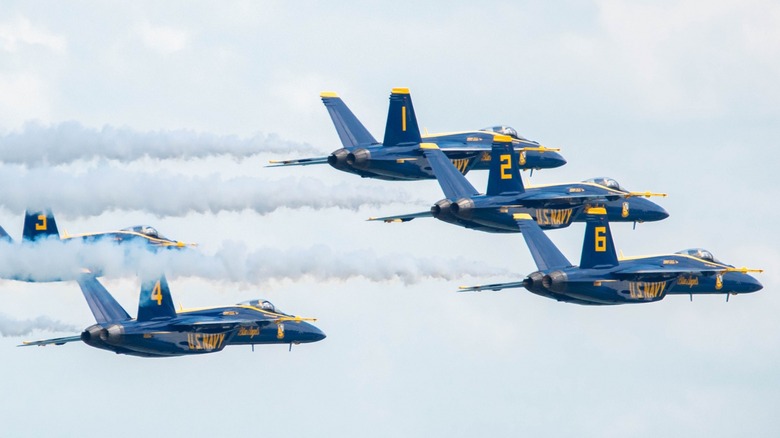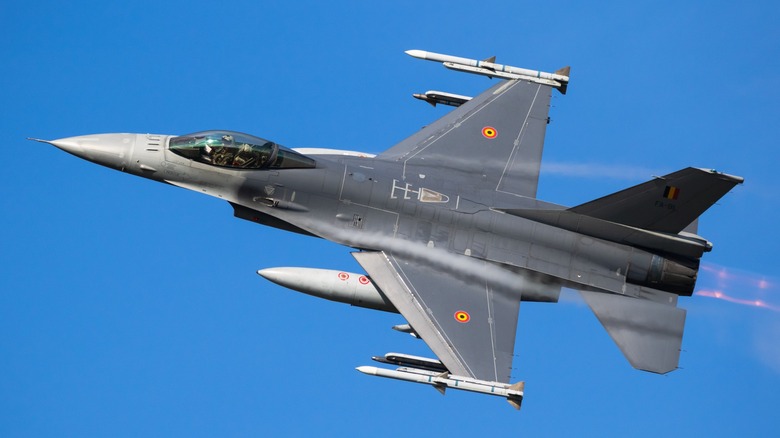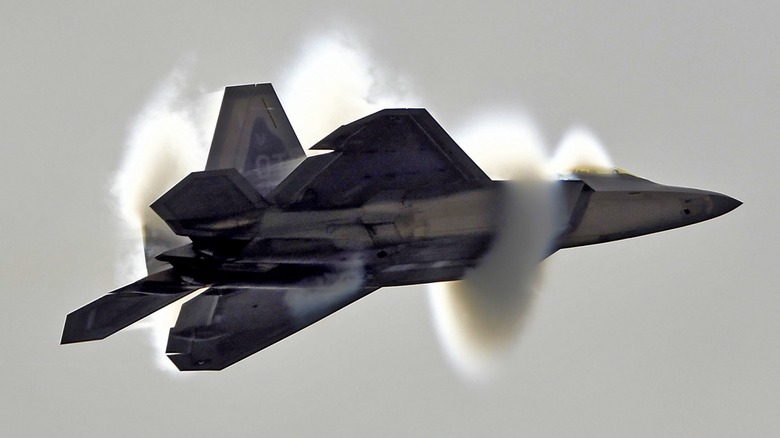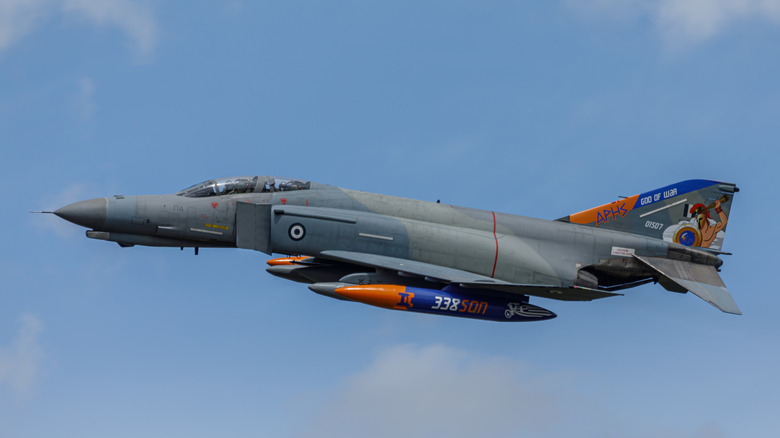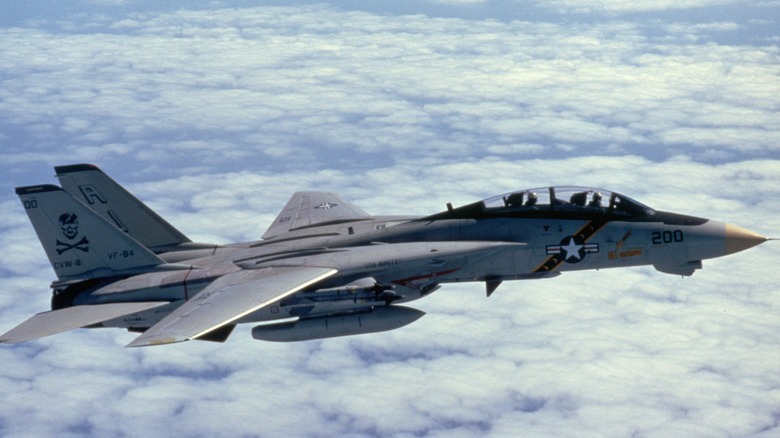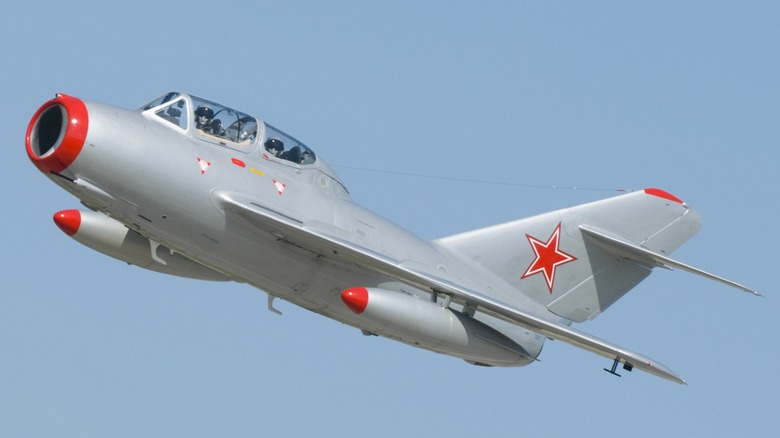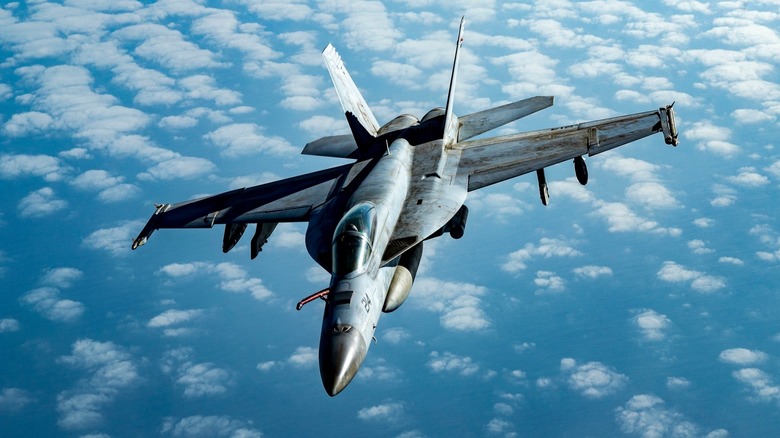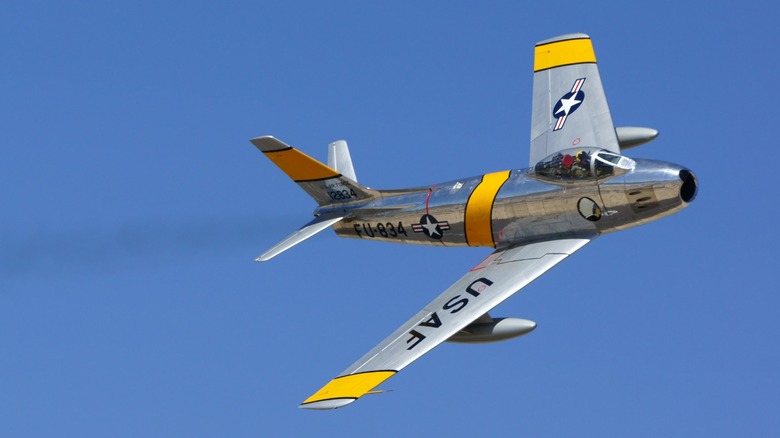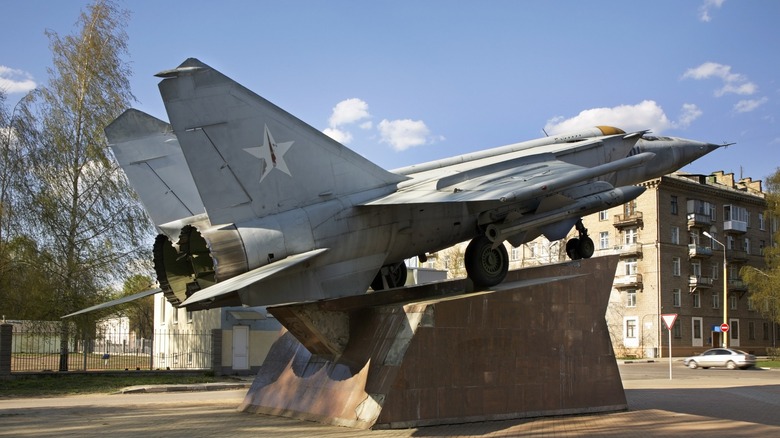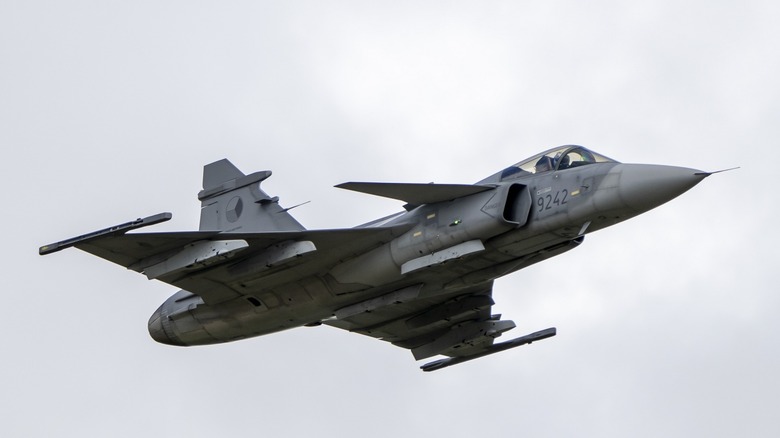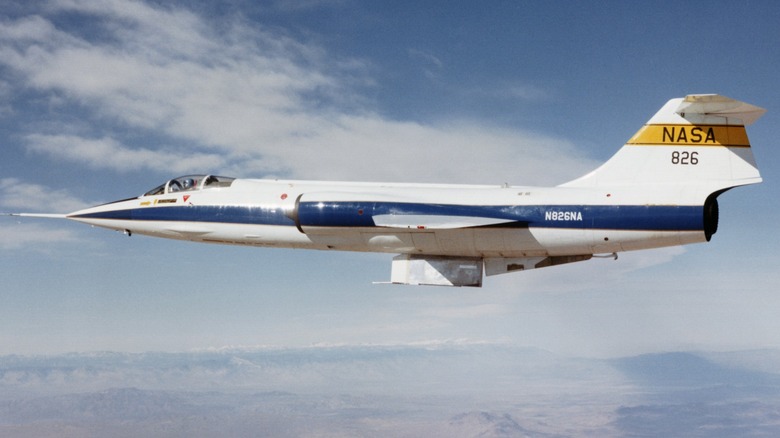10 Of The Most Iconic Fighter Jets Ever Built
Since the close of WWII, jet engine technology has advanced throughout the aviation industry, leading to the production of some of the most incredible military vehicles in history. Even before the war ended, fighter jets began playing a role in warfare as the Germans managed to build and deploy one of the first fighter jet models ever built, the Messerschmitt ME-262. While that jet failed to increase the capabilities of the Luftwaffe in WWII, fighter jets would go on to be crucial to the forces involved in modern conflicts.
Today, the fighter jet is the premier symbol of military supremacy in the air. Those countries that possess advanced jet fighters can project power in the skies through a combination of speed and firepower from the continued development of advanced airframes and weapons. Although fighter jets are flown by many nations, only a handful produce them, as substantial funding is required for development and manufacturing, leaving only those nations with the most advanced technological aviation sectors capable of building them. Despite this, a wide range of fighters have been produced through several eras of military production, and each aircraft serves a different role and is built with unique specifications. Furthermore, any jet-powered aircraft built that can fulfill the role of aerial fighter is bound to be an impressive machine, but these warplanes have proven themselves as the most iconic ever built.
Lockheed Martin F-16 Fighting Falcon
After flying for 50 years, the F-16 Fighting Falcon continues to impress. The maiden flight of its prototype happened in 1974 and the first planes were delivered to enter service in 1980. The F-16 broke ground in several areas. It was the first modern American fighter to use fly-by-wire flight controls, disconnecting any physical link to the pilot in favor of an all-electronic system. It is a highly maneuverable aircraft, thanks to its incredibly low weight and advanced avionics. It is also highly capable, able to withstand up to nine G with full tanks of fuel, and hit a top speed of Mach 2.
The F-16 has become an incredibly popular aircraft. One of its original strengths was its low-cost production, which continues to be a factor in its acquisition by various military services. Furthermore, it has achieved 72 air-to-air kills with zero losses while engaged in combat. It has also been upgraded several times with updated radar, fire control systems, and avionics. Currently, Lockheed Martin continues to manufacture the updated F-16 Block 70, featuring state-of-the-art upgrades. Even Ukraine is attempting to procure some of them in its ongoing conflict with Russia, and pilots are already training for what appears to be their imminent arrival.
It is a rare plane that can fly for 50 years and still enjoy as high a level of demand as the F-16 does. The new aircraft coming from Lockheed right now are likely to function for the next 30 to 40 years, meaning the F-16 has a lot of flying left to do.
Lockheed Martin F-35 Lightning II
The most recently developed fighter jet in the American arsenal is also the most advanced ever created. Built as a fifth-generation stealth aircraft, the Lockheed Martin F-35 Lightning II is nothing short of a technical marvel. To call the F-35 merely a fighter jet is almost a misnomer. The truth about this aircraft is that its communications capabilities almost overshadow its ability to deliver hellfire down from the heavens.
When discussing the F-35, the lead is its stealth technologies, qualities built into its airframe that make it practically non-existent to radar. It shows up on radar about the same size as a wildly errant golf ball. Maintaining its stealth requires an internal weapons bay to keep its actual Hellfire missiles and other payloads from casting a signature. But the real highlight of this fighter is its networking and communications suite, which are connected directly to a sophisticated augmented-reality helmet using a heads-up display visor. The helmet alone is a $400,000 component.
The F-35 is outfitted with an array of sensors and cameras that give the pilot full situational awareness. These components are integrated through the plane's on-board network. The aircraft can connect to other planes within a squadron, or a command center many miles away, including offshore warships. Additionally, it communicates with satellites to send and receive information, providing a two-way stream of information on real-time battlefield conditions along with instant orders from a commander. The avionics also feature a degree of integrated AI, giving pilots more freedom to concentrate on tactical decisions over actual flying. The plane is already a legend.
McDonnell F-4 Phantom II
When it was introduced, the McDonnell F-4 Phantom II established several records for speed, altitude, and climb rate. The twin-engine supersonic aircraft came with a range of weapons and advanced systems that were at the cutting edge of the era, providing the Navy with an advanced aircraft that would become one of the most important military assets of its day.
Capable of flying missions in all weather, the F-4 carried weapons on its nine pylons that included the best guided missiles and active radar technology available. In contrast to the fighters that came before, this one carried a crew of two instead of one, due to the new equipment requiring an additional crewmember to operate. It was also clearly created for a different purpose from its dogfighting predecessors, as it came with no onboard guns which, according to its pilots, may have been an oversight.
As the primary fighter-bomber of the '60s and '70s, the F-4 was crucial to dozens of missions over Vietnam, with a high level of success. The F-4 continued to serve the Air Force through 1996, providing air support in Desert Storm before its retirement. However, it still serves a role for the American military today as the remaining aircraft have been converted to unmanned and remote-controlled QF-4 aircraft used as targets during live-fire exercises and training.
Grumman F-14 Tomcat
Introduced in the 1970s as the Navy's ultra-modern carrier-based supersonic fighter, the Grumman F-14 Tomcat helped the American military to assert its dominance through the waning days of the Cold War. Its design originated in the 1960s, and decisions regarding its construction were based on real-world lessons gleaned from the experiences of fighter pilots in the conflict in Vietnam.
The defining feature of the F-14 is the swing-wing design. With its wings mounted on mechanical pivots, the F-14 can operate with traditional out-swept wings for takeoff, landing, and low-speed maneuvers. The wings can then be adjusted back into a fully swept-wing configuration for stable high-speed flight. This makes the F-14 extremely versatile and capable while maintaining high speed, stability, and maneuverability. Besides the airframe improvements, the systems of the F-14 featured the best technology of its day. With Phoenix AIM-54A missiles and a Hughes AWG-9 radar, a Tomcat could locate and destroy a target from 100 miles away or more. Furthermore, once a pilot has expended all weapons stored on its hardpoints, it can fall back on a 20mm rotary cannon.
F-14 aircraft continued to be used by the Navy until the second incursion into Iraq, after 9/11. The Navy retired its aircraft in 2006, but it remains flying in Iran, whose air force received them before the 1979 Islamic Revolution. Despite its impressive military service, the F-14 reached icon status primarily by being prominently featured in the 1986 hit film, "Top Gun."
Mikoyan-Gurevich MiG-15
The Soviet Union exited WWII in a very powerful position, having established itself as one of two powers facing off in a new polar geopolitical world. With a broad swath of territory under its direct or subordinate control, it became a huge industrial power. Fortunately for the Soviets, before relations completely cooled, Britain offered Josef Stalin access to its new jet engine technology, which the Soviets immediately began studying to make their own copy. This led to the first Soviet fighter jet, the MiG-15.
The British supplied dozens of Rolls-Royce Nene engines on the condition they not be used for military purposes, and the Soviets reverse-engineered them immediately to create the VK-1 turbojet engine. This was installed in a new airframe featuring swept wings that could reach speeds of up to 678 mph, faster than any contemporary British or American jet, with a superior climb rate. An industrious 12,000 jets were produced by the Soviets, with an additional 6,000 copies made in Poland, China, and Czechoslovakia.
The first combat engagements of the new aircraft occurred over the Korean peninsula starting in 1950 and initially dominated UN forces, using its fast climb rate and high service ceiling to stay out of danger. While pilot skill and military planning ultimately erased the technical advantages, the MiG-15 presented a capable adversary, posing a significant threat to the West. Additionally, with 18,000 copies produced in total, it remains the most widely produced fighter jet in history, making it an indelible symbol of the early Cold War.
Boeing F/A-18 Super Hornet
The road to putting the Boeing F/A-18 Super Hornet in the air stretched back around two decades before it was finally delivered to the Navy in 1983. The F/A-18's development occurred at the same time that the F-16 Fighting Falcon was being evaluated. While the Air Force ultimately chose the F-16, the Navy opted for the Super Hornet, believing an airframe powered by dual engines is ultimately better suited for carrier-based missions.
This aircraft entered service with the U.S. Navy as the F/A-18 Hornet. Its F/A designation stems from its capabilities both as a fighter and attack aircraft, with the Marines using it as the former and the Navy as the latter. However, its capabilities and robust equipment list give it the ability to quickly switch to either role, or serve as a reconnaissance aircraft when necessary. While it carries a Vulcan 20mm cannon, its primary weapons are mounted below, and the Hornet can be equipped with a wide range of weapons, including Sidewinder, Sparrow, and Maverick missiles in addition to JDAM, Paveway Laser Guided Bombs, a data link pod, or other various mines or rockets.
With a top speed of Mach 1.8 and a service ceiling of 50,000 feet, other fighter jets can fly faster and higher, but a properly equipped Super Hornet is a formidable foe and not one to be trifled with. The Navy currently uses F/A18 Super Hornets introduced in 1999 and the EA-18G Growler, which entered service in 2010.
North American F-86 Sabre
While it was not the first jet-powered fighter deployed by the U.S. Military, the F-86 Sabre was the first to achieve large-scale combat success. Development of this aircraft occurred as the Allies swept across Europe and the islands of the Pacific to defeat the tyrannical power of the Axis countries. A prototype first flew in 1947 and officially entered service in 1949, just in time for the Korean War to kick off.
Victory in Europe gave American forces access to the engineering and research developed by Germany, including a great deal of aviation material. They discovered that a swept-wing design is ideal for high-speed stability, although engineers later discovered this caused issues at lower speeds. To counter this, they added automatic leading edge slats, which resolved the issue.
The Sabre got its chance to prove itself in battle over the Korean peninsula, where fresh MiG-15s of the North Korean army had been wreaking havoc with America's pilots. The MiG-15 was a superior aircraft in many ways, but the Sabre established air superiority because of its excellent agility. Furthermore, the first air-to-air missile shot during combat came from a Sabre against a MiG in 1958. Though it has been outclassed by many jets produced in the years since the Korean War, the F-86 Sabre set the stage for American air superiority that has existed ever since, making it an icon of American military power.
Mikoyan-Gurevich MiG-25
The 1960s saw some of the best engineering ever to come from the Soviet Union. With the Cold War running very hot, the USSR saw existential threats all around as Western alliances continued to build military capabilities on land, sea, and air. One of the aircraft to be designed in the era was the Mikoyan-Gurevich MiG-25, among the most impressive aircraft to be built by the Red Empire.
Designs began to be fleshed early in the '60s, leading to a public introduction in 1967. This led to alarm bells within the halls of the Pentagon, as top Defense officials feared an aircraft that outclassed their own in the hands of the Soviets. The concerns were legitimate, as the MiG-25 specifications were impressive. It was capable of hitting Mach 3, with a nearly 80,000-foot ceiling. Depending on how it was equipped, it stood a real chance of achieving superiority over any Western plane, as the United States only had one aircraft that could match that speed, the SR-71 Blackbird. The problem with that plane is that it was used for reconnaissance only and carried no weapons.
While American officials debated how to counter the MiG-25, a daring Russian pilot broke formation while flying in a squadron and landed on a runway in Hokkaido, Japan. The pilot defected, and American engineers got to study the aircraft, quickly determining that their fears had been overstated and that it was deficient in many ways. Regardless, it was still blazingly fast, and the subject of a legendary tale of the Cold War.
Saab JAS 39 Gripen
Although American fighter jets often receive the most praise and a lot of press coverage, this may leave a few European models a bit overlooked. Furthermore, French and British aircraft get the spotlight when eyes are on Europe, but the Swedes have also been making jet fighters for many years. One of the world's most advanced jets today is the Saab JAS 39 Gripen, which deserves a closer look.
The Gripen is a unique aircraft in many ways. The design features a cropped delta wing accompanied by two forward canards, adding additional stability. It is powered by a Volvo engine with an afterburner, giving it a top speed of Mach 2 and a service ceiling of 50,000 feet. It was designed to be a lightweight plane, and its total weight comes in at about three-quarters of the weight of an F-16 Fighting Falcon, itself a lightweight fighter. This was accomplished by the extensive use of composite materials in its assembly.
While Sweden has been historically neutral, it has kept up a formidable military for self-defense purposes. Part of its readiness is maintained with its air force, and the newest Saab JAS 39 Gripen E could hold its own against nearly any adversary it opposed, even if they were in an American F-35. The Gripen is not a stealth aircraft but does maintain a smaller radar cross-section than anything but the F-22 and F-35. Equipped with cutting-edge radar, avionics, and powerful guided weapons, this Saab is a boon to any air force that wields it.
Lockheed F-104 Starfighter
As the United States figured out how to make capable jet fighters, it soon started to push the boundaries of what could be done with the technology. With its first flight in 1954, the F-104 Starfighter became an important part of NATO operations and was exported to at least a dozen countries. It also set records as the first aircraft to double the speed of sound and broke an altitude record when it hit 103,395 feet in 1959. Its shape makes it look more like a huge jet engine with wings and leads many to call it a "missile with a man in it."
The wings of the Starfighter are unusually short and its wingspan is only 21 feet. They have an extremely sharp leading edge to pierce through the sky — covers were made for the wings to prevent injuries to ground crew. The fuselage is tightly wrapped around the engine, which takes up so much space that most electronics have to be packaged to fit within the cockpit. The only arms are an M-61 Vulcan 20mm Gatling gun and two missile hardpoints on the ends of the wings. This aircraft was built for dogfighting during the day, and had the climb rate and acceleration to excel in this capacity.
The F-104 Starfighter is an interesting part of our military history. It may not have seen much in the way of significant combat, nor is it known for any prominent engagements, but its shape makes it one of the most interesting and iconic planes of its era.
